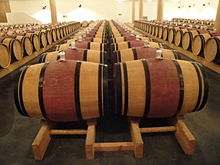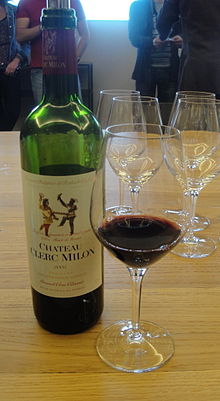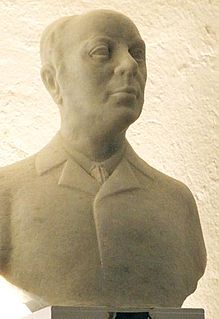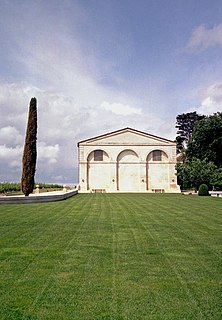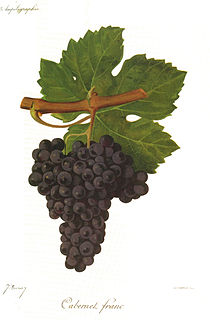
The Bordeaux Wine Official Classification of 1855 resulted from the 1855 Exposition Universelle de Paris, when Emperor Napoleon III requested a classification system for France's best Bordeaux wines that were to be on display for visitors from around the world. Brokers from the wine industry ranked the wines according to a château's reputation and trading price, which at that time was directly related to quality.
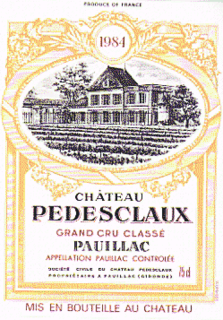
Château Pédesclaux is a winery in the Pauillac appellation of the Bordeaux region of France. The wine produced here was classified as one of eighteen Cinquièmes Crus in the Bordeaux Wine Official Classification of 1855.
Château Lynch-Bages is a winery in the Pauillac appellation of the Bordeaux region of France. Château Lynch-Bages is also the name of the red wine produced by this property. The wine produced here was classified as one of eighteen Cinquièmes Crus in the Bordeaux Wine Official Classification of 1855.

Château Grand-Puy-Lacoste is a winery in the Pauillac appellation of the Bordeaux region of France. Chateau Grand-Puy-Lacoste is also the name of the red wine produced by this property. The wine produced here was classified as one of eighteen Cinquièmes Crus in the Bordeaux Wine Official Classification of 1855.
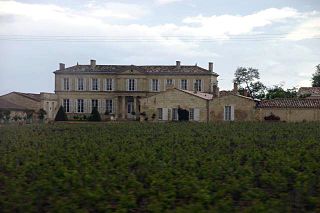
Château Branaire is a winery in the Saint-Julien appellation of the Bordeaux region of France. Château Branaire is also the name of the main red wine produced by this property and which was classified as one of the ten 'Fourth Growths' in the Bordeaux Wine Official Classification of 1855.

Château Pontet-Canet is a winery in the Pauillac appellation of the Bordeaux wine region of France. Chateau Pontet-Canet is also the name of the red wine produced by this property. The wine produced here was classified as one of eighteen Cinquièmes Crus in the Bordeaux Wine Official Classification of 1855.
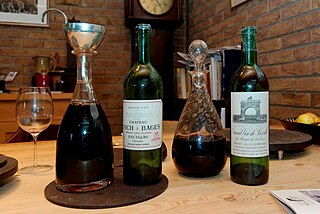
Château Léoville-Las Cases is a winery in the Saint-Julien appellation of the Bordeaux region of France. Château Léoville-Las Cases is also the name of the red wine produced by this property. The wine produced here was classified as one of fifteen Deuxièmes Crus in the original Bordeaux Wine Official Classification of 1855.
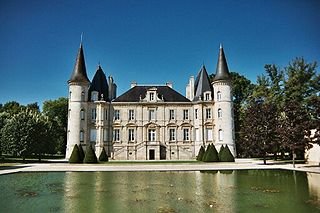
Château Pichon Longueville Baron or Château Longueville au Baron de Pichon-Longueville is a winery in the Pauillac appellation of the Bordeaux region of France. Château Pichon Longueville Baron is also the name of the red wine produced by this property. The wine produced here was classified as one of fifteen Deuxièmes Crus in the original Bordeaux Wine Official Classification of 1855.

Château Lynch-Moussas is a French winery in the Pauillac appellation of the Bordeaux region of France. Château Lynch-Moussas is also the name of the red wine produced by this property. The wine produced here was classified as one of eighteen Cinquièmes Crus in the Bordeaux Wine Official Classification of 1855.
Château Brane-Cantenac is a winery in the Margaux appellation of the Bordeaux wine region of France. The wine produced here was classified as one of fifteen Deuxièmes Crus in the original Bordeaux Wine Official Classification of 1855.
Château Pichon Longueville Comtesse de Lalande is a winery in the Pauillac appellation of the Bordeaux region of France. Château Pichon Longueville Comtesse de Lalande is also the name of the red wine produced by this property. The wine produced here was classified as one of fifteen Deuxièmes Crus in the original Bordeaux Wine Official Classification of 1855.

Château Cos d'Estournel is a winery in the Saint-Estèphe appellation of the Bordeaux region of France. It is also the name of the red wine produced by this property. The wine produced here was classified as one of fifteen Deuxièmes Crus in the original Bordeaux Wine Official Classification of 1855.
Château Kirwan is a winery in the Margaux appellation of the Bordeaux region of France. The wine produced here was classified as one of fourteen Troisièmes Crus in the historic Bordeaux Wine Official Classification of 1855.

Château d'Issan is a castle and winery in the Margaux appellation of the Bordeaux region of France. The wine produced here was classified as one of fourteen Troisièmes Crus in the historic Bordeaux Wine Official Classification of 1855. The winery is under the proprietorship of Emmanuel Cruse, of the Cruse family. In February 2013, 50% of the estate was purchased by Jacky Lorenzetti, who also owns Château Pédesclaux in Pauillac & Chateau Lilian Ladouys in Saint-Estèphe.
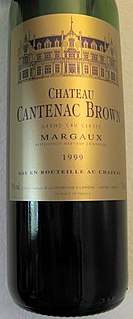
Château Cantenac-Brown is a winery in the Margaux appellation of the Bordeaux region of France. The wine produced here was classified as one of fourteen Troisièmes Crus in the historic Bordeaux Wine Official Classification of 1855. The Château has 118 acres (0.48 km2) planted with Cabernet Sauvignon, Merlot and Cabernet Franc. The Château produces a second wine labeled as Brio de Cantenac-Brown.
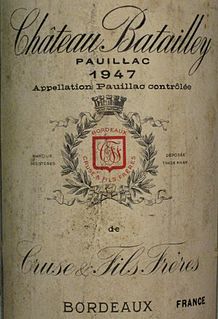
Château Batailley is a winery in the Pauillac appellation of the Bordeaux region of France. The wine produced at the estate was classified as one of eighteen Cinquièmes Crus in the Bordeaux Wine Official Classification of 1855.

Château Haut-Batailley is a winery in the Pauillac appellation of the Bordeaux region of France. The wine produced here was part of the property that was classified as one of eighteen Cinquièmes Crus in the Bordeaux Wine Official Classification of 1855.
Château d'Armailhac, previously named Château Mouton-d'Armailhacq, Château Mouton-Baron Philippe, Mouton Baronne and Château Mouton-Baronne-Philippe (1979–1988), is a winery in the Pauillac appellation of the Bordeaux region of France. The wine produced here was classified as one of eighteen Cinquièmes Crus in the Bordeaux Wine Official Classification of 1855.

Château Gloria is an unclassed Bordeaux wine from the Saint-Julien appellation. The winery is located in the central part of France’s Bordeaux wine region Haut-Médoc, in the commune of Saint-Julien-Beychevelle.

